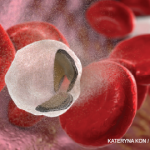
Immune system defense cells attack a virus.
Westend61 Premium/shutterstock.com
WASHINGTON, D.C.—Speaking at the 2016 ACR/ARHP Annual Meeting in a session titled ARHP: Immunology Boot Camp I: Basis of Targeted Therapy, a rheumatologist and immunology expert gave a guided tour of the immune system, described what can go wrong with it and outlined what physicians can do when it does.
Troy Torgerson, MD, PhD, associate professor of pediatric immunology and rheumatology and director of the Immunology Diagnostic Laboratory at the University of Washington in Seattle and Seattle Children’s Hospital, separated the immune system into four compartments, likened it to the military and offered a framework that can be valuable to clinicians.
Breaking It Down
The complement compartment of the immune system, he said, includes land mines that explode into action when triggered. According to Dr. Torgerson, phagocytes are like the Marines. Like U.S. Marines crawl through mud to a battlefield, phagocytes work their way through tissue to sites of inflammation. B cells, he said, are the Air Force, making and deploying cruise missile-like attacks on bodily invaders. And T cells are like the generals, assassins and psychologists, guiding B cell attacks, killing infected cells and regulating other immune cells.
Thinking of disease as defective compartments within the immune system can be a helpful approach in diagnosing and managing patients, Dr. Torgerson said.
“When we sit down in clinic and [walk] through patient [files], I encourage our fellows and our students to actually think about, ‘Could this patient have a defect in complement, phagocytes, B cells, T cells?’ [I] just try to get their heads around what might be the defective compartment,” Dr. Torgerson said. “The immune system is like the military that protects your body, or your homeland, against invaders and prevents invaders, such as viruses and bacteria, from coming in, taking over and trying to take down your homeland.”
Complement Compartment
Dr. Torgersen said it’s useful to think of the complement compartment as containing the land mines, proteins that are floating around in the plasma, waiting for something to come along and stumble onto them, such as a bacterium. Activation or cleavage events prompt the production of the membrane attack complex, which punches a hole in the bacterium, causing an explosion.
‘The immune system is like the military that protects your body, or your homeland, against invaders.’— Dr. Troy Torgerson.
The complement system, part of innate immunity, can be activated in three different ways: the classical pathway, with complement activated by immune complexes; the lectin pathway, with activation by pathogen oligosaccharides; and the alternative pathway, with activation by pathogen surfaces. They all converge on the activation of C3, which leads to the membrane attack complex, comprising C5–9.
It’s a system under “very tight regulation,” Dr. Torgerson said, with factors essentially holding the system at bay at various levels, such as factor H at the C3 level, and CD59 at the level of C8 and 9.
Defects in the complement system can lead to profound problems. People with a C1 deficiency have a 90% chance of developing lupus, Dr. Torgersen said. Those deficient in C2—the most common complement deficiency—have a 40% chance of developing lupus and require regular lupus screening.
Patients can be treated by replenishing complement via fresh frozen plasma, he said. Patients deficient in C1 inhibition could benefit from a recombinant C1 inhibitor. Eculizumab binds to C5, blocking the formation of the membrane attack complex. Its price is exorbitant, but it works well in patients who really need it, he said.
Phagocyte Compartment
Phagocytes, part of innate immunity, roll down the walls of blood vessels, sticking and releasing, sampling their environment as they go. When they encounter an infection, cytokines and chemokines are sent out by the tissue cells, essentially asking for help.
Dr. Torgersen calls phagocytes the Marines of immunity because neutrophils are then produced and crawl out into the tissue to the site of the infection and gorge themselves on bacteria or other invaders. After that, they throw up on themselves, as he put it, presenting what they’ve eaten on major histocompatibility complex cells in a display that’s arrayed like a hot dog in a bun to appeal to T cells and other immune cells.
People with deficiency in this compartment—causing adhesion deficiency, preventing phagocytes from sticking and rolling, or sticking down hard when there’s an infection to fight, or causing problems with phagocytes’ digestive ability—tend to get recurrent skin and soft tissue abscesses and chronic granulomatous disease.
Colchicine interferes with the formation of microtubules that neutrophils need to survive. And steroid treatment, although not specific to phagocyte function, acts as a brake so that neutrophils don’t migrate and function as well.
B Cell Compartment
B cells are like the Air Force of the immune system, deploying antibodies like cruise missiles, Dr. Torgersen said. They have a complex maturing process, going from immature cells in the bone marrow, then migrating to the periphery as they mature, then becoming fully mature as memory cells or plasma cells, factories, in effect, that produce antibodies, he said.
Patients on repeated treatments with B cell-depleting therapies, who are deficient in B cells or antibodies, can have recurrent infections, such as sinus infections or pneumonia.
“When they come to clinic, just add to your questions that you ask them: ‘Have you had any problems with infections or recurrent infections? Any problems with sinusitis this year?’ And what you find may surprise you,” Dr. Torgersen said.
IgG replacement can be used to give antibodies back to patients, helping patients with immune deficiency and autoimmunity.
B cell-targeted biologic therapies, such as anti-CD20 treatment, can be used to knock out or knock down B cell populations, typically not in the bone marrow but in the developing phases. Only one drug, bortezomib, destroys plasma cells, at least to a degree.
T Cell Compartment
The T cells are the generals that direct B cells to attack invaders. The assassin T cells are CD8-positive cytotoxic T cells that kill cells infected with such pathogens as viruses and fungi. And the psychologist T cells are regulatory cells that direct other immune cells and modulate their responses.
Patients lacking T cells are prone to recurrent or severe infections. Those lacking regulatory T cells, a disorder known as Ipex syndrome, tend to develop early-onset autoimmune disease.
T cell activity is tightly regulated by checkpoint inhibitors that block inhibitory receptors, such as programmed cell death-1 (PD-1) and cytotoxic T-lymphocyte-associated protein 4 (CTLA-4); as well as drugs, such as JAK inhibitors, which interfere with the activity of interleukin 2.
But there is a flip side to the anti-cancer effects of checkpoint inhibition, he said.
“If you’re like us, you’re beginning to see patients who’ve been treated with these checkpoint inhibitors for their cancers who now develop bad autoimmune disease,” he said. “When you block these two signals [PD1 and CTLA-4], it just allows T cells to go crazy and to attack cancer and to make autoimmunity.”
Thomas R. Collins is a freelance writer living in South Florida.
